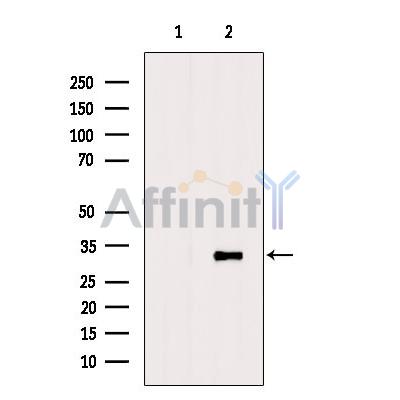CIP29 Antibody - #DF12899
| Product: | CIP29 Antibody |
| Catalog: | DF12899 |
| Description: | Rabbit polyclonal antibody to CIP29 |
| Application: | WB IF/ICC |
| Reactivity: | Human, Mouse, Rat, Monkey |
| Prediction: | Pig, Horse, Sheep, Rabbit, Dog |
| Mol.Wt.: | 32 kDa; 24kD(Calculated). |
| Uniprot: | P82979 |
| RRID: | AB_2845860 |
Related Downloads
Protocols
Product Info
*The optimal dilutions should be determined by the end user. For optimal experimental results, antibody reuse is not recommended.
*Tips:
WB: For western blot detection of denatured protein samples. IHC: For immunohistochemical detection of paraffin sections (IHC-p) or frozen sections (IHC-f) of tissue samples. IF/ICC: For immunofluorescence detection of cell samples. ELISA(peptide): For ELISA detection of antigenic peptide.
Cite Format: Affinity Biosciences Cat# DF12899, RRID:AB_2845860.
Fold/Unfold
Cytokine induced protein of 29 kDa; Cytokine-induced protein of 29 kDa; HCC 1; HCC1; HSPC316; Nuclear protein Hcc 1; Nuclear protein Hcc-1; Proliferation associated cytokine inducible protein CIP29; Proliferation-associated cytokine-inducible protein CIP29; SAP domain-containing ribonucleoprotein; SARNP; SARNP_HUMAN; THO1;
Immunogens
A synthesized peptide derived from human CIP29, corresponding to a region within the internal amino acids.
Low expression in spleen, liver, pancreas, testis, thymus, heart, and kidney. Increased levels are seen in hepatocellular carcinoma and pancreatic adenocarcinoma.
- P82979 SARNP_HUMAN:
- Protein BLAST With
- NCBI/
- ExPASy/
- Uniprot
MATETVELHKLKLAELKQECLARGLETKGIKQDLIHRLQAYLEEHAEEEANEEDVLGDETEEEETKPIELPVKEEEPPEKTVDVAAEKKVVKITSEIPQTERMQKRAERFNVPVSLESKKAARAARFGISSVPTKGLSSDNKPMVNLDKLKERAQRFGLNVSSISRKSEDDEKLKKRKERFGIVTSSAGTGTTEDTEAKKRKRAERFGIA
Predictions
Score>80(red) has high confidence and is suggested to be used for WB detection. *The prediction model is mainly based on the alignment of immunogen sequences, the results are for reference only, not as the basis of quality assurance.
High(score>80) Medium(80>score>50) Low(score<50) No confidence
Research Backgrounds
Binds both single-stranded and double-stranded DNA with higher affinity for the single-stranded form. Specifically binds to scaffold/matrix attachment region DNA. Also binds single-stranded RNA. Enhances RNA unwinding activity of DDX39A. May participate in important transcriptional or translational control of cell growth, metabolism and carcinogenesis. Component of the TREX complex which is thought to couple mRNA transcription, processing and nuclear export, and specifically associates with spliced mRNA and not with unspliced pre-mRNA. TREX is recruited to spliced mRNAs by a transcription-independent mechanism, binds to mRNA upstream of the exon-junction complex (EJC) and is recruited in a splicing- and cap-dependent manner to a region near the 5' end of the mRNA where it functions in mRNA export to the cytoplasm via the TAP/NFX1 pathway. The TREX complex is essential for the export of Kaposi's sarcoma-associated herpesvirus (KSHV) intronless mRNAs and infectious virus production.
Nucleus. Nucleus speckle.
Low expression in spleen, liver, pancreas, testis, thymus, heart, and kidney. Increased levels are seen in hepatocellular carcinoma and pancreatic adenocarcinoma.
Restrictive clause
Affinity Biosciences tests all products strictly. Citations are provided as a resource for additional applications that have not been validated by Affinity Biosciences. Please choose the appropriate format for each application and consult Materials and Methods sections for additional details about the use of any product in these publications.
For Research Use Only.
Not for use in diagnostic or therapeutic procedures. Not for resale. Not for distribution without written consent. Affinity Biosciences will not be held responsible for patent infringement or other violations that may occur with the use of our products. Affinity Biosciences, Affinity Biosciences Logo and all other trademarks are the property of Affinity Biosciences LTD.


